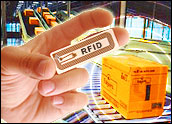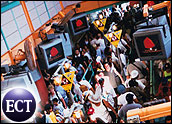
Three technology companies have joined together to propel radio frequency identification applications forward. OATSystems, ADT Security Systems and Intel are paying for technology implementation to win grocery retailers over to RFID investment.
Grocers suffer from slim profit margins. That means they’re hesitant to pull a Wal-Mart and engage RFID technology. The upfront costs are too great and the payoff uncertain. So ADT is contributing RFID readers and antennas, OAT is adding middleware and Intel is offering server processors to remove one of grocers’ barriers to track in-store promotions with this emerging technology.
“The whole industry has been out looking for the ROI for deploying RFID,” says Randy Dunn, director of RFID for ADT. The three vendors and consumer packaged goods manufacturers such as Kimberly-Clark and Procter & Gamble have put out a call for retailers to participate in a six-month trial in which they’ll show that sell-through of one additional promotional product per store pays for the technology.
Scalable Technology
ADT readers will be placed at the distribution center and store receiving docks, the threshold between the storeroom and store floor and the box crusher. The wireless hardware will transmit tag data to OAT software that will manipulate it for retailer and consumer packaged goods learning.
All three vendors provide open-standards tools. This is critical — in the short-term for the retailers so that they may use the technology after the trial to measure promotions. Additional functionality can be built into this RFID program in the future, with components from any number of vendors.
Until technology produced a toolset to measure promotion execution, suppliers had to hire third-party auditors to visit stores and confirm displays were on the sales floor, in the location discussed. Because of the cost and manual processing involved, only a small number of stores were audited.
The data collected and analyzed in this trial will allow suppliers to plan smarter promotions and retailers to increase sell-through. “From a technology perspective, this is one of the simplest things to do with RFID,” says Marc Osofsky, vice president of marketing and product management for OAT.
A Win-Win
RFID tags on cardboard promotional displays will show the Consumer Packaged Goods (CPG) supplier when retailers receive the materials, when they place them on the sales floor and where they place them. Sometimes displays fail to arrive at stores. Other times they are not moved to the sales floor until after the promotion period has begun. Or some stores presell product intended for a special marketing event. Research from the National Association for Retail Merchandising Services shows that 56 percent of promotions are not properly executed.
“Execution of promotions is both important and substandard right now,” ADT’s Dunn tells CRM Buyer. “The promotional area requires high collaboration [between suppliers and retailers], but it has not been fact-based to make decisions on.”
“This is a need that has been screaming for a solution,” adds Don Stuart, managing director of CPG consultancy Cannondale Associates. “CPGs will understand promotional performance — how well the product moved off the display — and retailer compliance [with RFID].”
The five to 10 participating CPG suppliers will gain better forecast accuracy and will plan promotions, including product inventory, better by region, even by store. They’ll be better able to allocate the 16 percent of sales CPG manufacturers typically spend on marketing promotions, Stuart tells CRM Buyer. “RFID has a lot of promise. It fills in an incredibly big insight gap,” he says.
Broad Buckets of ROI
In a study of Wal-Mart’s RFID program, the Massachusetts Institute of Technology found a 19 percent increase in promotional sales attributable to RFID tags, readers and data analysis. This trial aims to help CPG suppliers and retailers increase sales, decrease marketing costs and increase shopper satisfaction.
ROI also will appear in the information value of the RFID data, Osofsky says. “People could never separate out promotion execution from sales,” he says. “They had point-of-sale data. But if the [promotional sales] numbers were bad, they weren’t sure why.
“Now you can tease out execution from sales — what’s a good display, what’s a bad display — and figure out what works best,” he says.
Ten stores from each of five unidentified retailers and five to 10 CPG suppliers will participate in this program, due to launch in time for back-to-school promotions. Infrastructure will be in place next month, and the RFID-tracked promotions will run through the holidays, with results released Q1 2007.
“Retailers want to know the sweet spot to get started with RFID. Promotions is a proven benefit area. ADT, Intel and OAT are convinced that the costs will definitely support the benefits they get,” Dunn says. “But as a kid, I never climbed a tree where it wasn’t within reach to get the first branch. How you get started has to be really safe.”










































